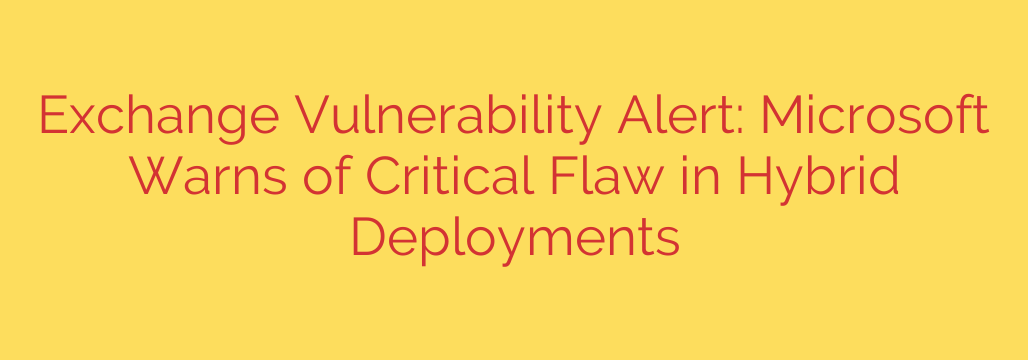
Urgent Security Alert: Critical Flaw in Microsoft Exchange Exposes Hybrid Environments
A critical security vulnerability has been identified in Microsoft Exchange Server, posing a significant threat to organizations utilizing hybrid email deployments. The flaw, tracked as CVE-2024-21410, carries a critical 9.8 CVSS score, reflecting its severity and the ease with which it can be exploited by malicious actors.
System administrators and cybersecurity professionals must take immediate action to mitigate this risk, as a successful attack could allow an unauthenticated, remote attacker to escalate their privileges and compromise the server.
Understanding the Threat: CVE-2024-21410 Explained
This vulnerability is a classic case of a privilege escalation flaw. It enables an attacker to exploit a weakness in how Microsoft Exchange handles authentication requests, specifically targeting NTLM (New Technology LAN Manager) credentials.
In a potential attack scenario, a threat actor could trick a user into connecting to a malicious server they control. This malicious server then captures the user’s Net-NTLMv2 hash and relays it to a vulnerable Exchange Server. This “pass-the-hash” technique effectively allows the attacker to authenticate on the Exchange server using the victim’s credentials, gaining access and privileges associated with that user account.
The most alarming aspect of this vulnerability is that it can be exploited by a remote and unauthenticated attacker, meaning they do not need prior access to the network or any valid credentials to launch their attack.
Who is at Risk? The Focus on Hybrid Deployments
This vulnerability specifically affects on-premises installations of Microsoft Exchange Server 2019.
While all Exchange 2019 servers should be patched, the primary risk lies within hybrid deployments. These are environments that combine on-premises Exchange servers with cloud-based Exchange Online services. The interaction between these two systems creates the specific conditions that make this NTLM relay attack possible. Organizations running purely on-premises or purely cloud-based environments are not considered vulnerable to this specific attack vector.
The Solution: Immediate Patching and Extended Protection
Microsoft has released a security update to address this vulnerability as part of its February 2024 Patch Tuesday release. However, simply installing the patch is only part of the solution. The core defense mechanism against this type of attack is a feature known as Extended Protection for Authentication (EPA).
EPA works by binding the authentication session to the outer TLS (Transport Layer Security) channel, which effectively prevents the credential relay attacks that CVE-2024-21410 relies on.
While Microsoft enabled EPA by default in the August 2022 Cumulative Update (CU) for Exchange Server 2019, some administrators may have disabled it to resolve compatibility issues. The new February 2024 security update re-enables and enforces EPA, making it a mandatory component for securing your server.
Actionable Security Steps for Administrators
To protect your organization from this critical threat, you must take the following steps without delay:
- Prioritize and Install the Update: The most crucial first step is to install the February 2024 security update for Microsoft Exchange Server 2019. This should be treated as an emergency patch.
- Verify Extended Protection is Active: Do not assume the patch has resolved everything. Use Microsoft’s provided scripts and health checkers to confirm that Extended Protection for Authentication (EPA) is enabled and functioning correctly across your Exchange environment. Manually disabling EPA will leave your servers exposed.
- Monitor for Suspicious Activity: Review your server logs for any unusual authentication patterns or signs of compromise, especially if patching was delayed. Look for unexpected successful logins from unfamiliar IP addresses.
The emergence of CVE-2024-21410 is a stark reminder of the sophisticated threats facing critical enterprise infrastructure. Proactive patching and diligent configuration management are essential to maintaining a strong cybersecurity posture and safeguarding your organization’s sensitive data.
Source: https://www.bleepingcomputer.com/news/microsoft/microsoft-warns-of-high-severity-flaw-in-hybrid-exchange-deployments/








